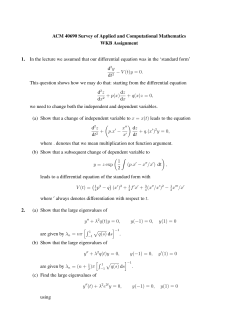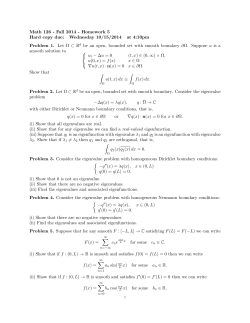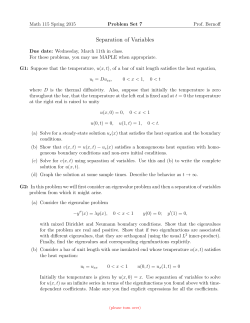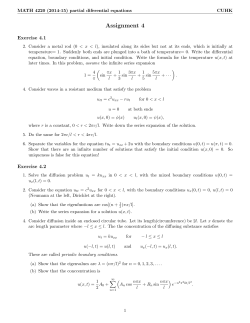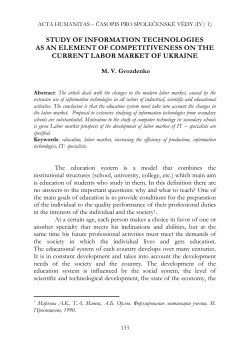
WKB solutions for the Orr-Sommerfeld equation
WKB solutions for the Orr-Sommerfeld equation By V. Nijimbere and L. J. Campbell In this paper we approximate the eigenvalues for the Orr-Sommerfeld equation for the two and three dimensional incompressible flows using the WKB methods. We derive the eigenfunctions in terms of Green’s functions. We also derive the corresponding outer solutions which give insight into the behavior of the solutions for large arguments (z → ∞). Our procedure consists of transforming the Orr-Sommerfeld equation into a system of two second order ordinary differential equations (ODEs). The method requires the eigenvalues to be sufficiently large, and takes into account the fourth order derivative regardless the values of the Reynolds number. The approximated eigenvalues can be used for example as a starting point in predicting transitions in boundary layers with computer simulations (CFD). 1. Introduction Stability and transitions in shear flow are not completely understood mechanisms. Both theoretical and experimental studies were made by different researchers in order to gain knowledge on some of the properties on transitions and stabilities in fluid flows and in boundary layers [6, 13]. Different types of instabilities that include linear inviscid, viscous and nonlinear instabilities, and transitions in shear flows and in boundary layers were investigated and many more [13]. Gregory et al. [7] analyzed the linear inviscid stability of the 3 dimensional boundary layer and applied it to the rotating disk flow but their results were biased. Brown [1] extended the work by Gregory et al. [7] and included the viscous effects by applying the Orr-Sommerfeld equation to the rotating disc and swept-back wing. He used the temporal instability theory but his results did not match the observed values. Cebeci Address for correspondence: Address and email id. DOI: 10.1002/sta.bility1 STUDIES IN APPLIED MATHEMATICS 00:1–18 c Wiley Periodicals, Inc., A Wiley Company ° 1 2 V. Nijimbere & L. J. Campbell and Stewartson [4] used the spatial stability theory and solved the OrrSommerfeld equation for the rotating disc profiles and their results were almost the same as Brown [1]. Cebeci and Stewartson [4] then suggested that the disturbances are wave packets propagating in three dimensional flows and used eN method, but they found that their N factor is very large compared to that for the LFC wings. Reid [12] derived an exact solution of the Orr-Sommerfeld for plane Couette flow. Malik et al. [10] improved Cebeci and Stewartson [4] computations by taking into account the effects due to the Coriolis forces and the streamwise curvature for the rotating disk flow, but their method increased the complexity of the solution as revealed by Cebeci and Chen [3]. Cooper and Carpenter [5] solved the stability of the rotating-disc boundary-layer flow over a compliant wall, and analyzed the Type I and II instabilities. But still the problem of stability and transition in shear flows is not well understood. Instead of solving the Orr-Sommerfeld equation in the limit of large Reynolds numbers and using the fact that the mean flow u ¯(z) = 0 in the boundary layer near the wall as discussed in Maslowe [11] or Schmid and Henningson [13], and where critical layers and singularities are introduced in the equations while the Orr-Sommerfeld equation does not have any, we assume that u ¯(z) = z, 0 < z < ∞, approximate the eigenvalues using WKB method and obtain approximate solutions in terms of Green’s functions. We also approximate the eigenvalues and the eigenfunctions for the configuration where the background mean flow is u ¯(z) = z 2 , 0 < z < ∞. Eigenvalues and eigenfunctions for the wake are approximated as well. The procedure that we use here requires the eigenvalues to be sufficiently large in order to use the WKB methods. On one hand the advantage of this procedure is that it works for any value of the Reynolds number, on another hand this procedure can always be used to approximate eigenvalues and eigenfunctions for the Orr-Sommerfeld equation for any type of the mean flow velocity profile in 3-D that can be represented in 2-D using the Squires’ theorem (transformation) as u¯(z) = a + bz + cz 2 , where a, b and c are arbitrary constants. 2. The Orr-Sommerfeld equation: from 3-D to 2-D We discuss the 3-D model and reduce it to 2-D. In stability theory of fluid flow, this procedure is known as the Squire’s theorem (or transformation), Schmid and Henningson [13]. In linear stability theory of fluid flow, as discussed in Schmid and Henningson [13], transitions from laminar to turbulent flow in shear flows and in boundary layers are governed by the WKB solutions for the Orr-Sommerfeld equation 3 Orr-Sommerfeld equation ¡ ¢ ¡ ¢2 φ0000 − 2 α2 + β 2 φ00 + α2 + β 2 φ ¡ ¡ ¢ ¢ ¡ ¢ − iR[(αF + βG − ω) φ00 − α2 + β 2 φ − αF 00 + βG00 φ] = 0 (1) with boundary conditions φ(a) = φ0 (a) = 0 and φ(b) = φ0 (b) = 0, (2) where prime stands for differentiation with respect to z, α and β are wavenumbers in streamwise and spanwise direction while F and G are background fluid flows in streamwise and spanewise directions respectively. Grouping together the terms according to φ000 , φ00 and φ, then equation (1) can be written as £ ¡ ¢ ¤ φ0000 − 2 α2 + β 2 + iR (αF + βG − ω) φ00 + h¡ ¢2 ¡ ¢ ¡ ¢i α2 + β 2 + iR (αF + βG − ω) α2 + β 2 + iR αF 00 + βG00 φ = 0. (3) Moreover letting k 2 = α2 + β 2 so that α = k cos θ and β = k sin θ, where θ is the orientation angle of the phase velocity in the horizontal plane, xy-plane, and substituting for α and β in the equation (3) gives h ³ ω ´i 00 φ0000 − 2k 2 + iRk cos θF + sin θG − φ + k h ³ ´ ¡ ¢i ω k 4 + iRk 3 cos θF + sin θG − + iRk cos θF 00 + sin θG00 φ = 0. k (4) Setting u ¯ = cos θF + sin θG implies u ¯00 = cos θF 00 + sin θG00 , and thus equation (4) becomes h ³ ³ i ω ´i 00 h 4 ω´ φ0000 − 2k 2 + iRk u ¯− φ + k + iRk 3 u ¯− + iRk¯ u00 φ = 0. (5) k k one may be interested in the where |k| is large (|k| À 1). ¯ configurations ¯ ω¯ ¯ If one further consider that u ¯ − k > 0 for all z, this means that the configurations with critical layers are not considered here, in that case the last term in (5) proportional to k is negligible comparing to that proportional k 3 and can be dropped. In addition, we observe that R can be of the same order of magnitude as |k|, and hence this allows us to keep all the others remaining terms in the coefficient of φ and that of φ00 . This gives ³ h ³ ω ´i ω ´i 00 h 4 φ + k + iRk 3 u ¯− φ = 0. (6) φ0000 − 2k 2 + iRk u ¯− k k 4 V. Nijimbere & L. J. Campbell We note that the condition |k| À 1 is very important (section 3) in order to derive the WKB solution for (6). We further observe that (6) is exact if u ¯ is a linear function of z, e.g. Couette flow. Now let us consider the differential operator ¸· 2 ¸ · 2 d d + Q(k, ω, z) + P (k, ω, z) . (7) dz 2 dz 2 Its expansion is · 2 ¸· 2 ¸ d d + Q(k, ω, z) + P (k, ω, z) dz 2 dz 2 d4 d2 d d = 4 + [P (k, ω, z) + Q(k, ω, z)] 2 + 2 P (k, ω, z) dz· dz dz ¸dz d2 + P (k, ω, z) + Q(k, ω, z)P (k, ω, z) . dz 2 Applying this differential operator to φ gives ¡ ¢ φ0000 + (P + Q)φ00 + 2P 0 φ0 + P 00 + QP φ = 0. (8) (9) Comparing this with (6) yields h ³ ω ´i P + Q = − 2k 2 + iRk u ¯− , k ³ ω´ QP = k 4 + iRk 3 u ¯− k (10) (11) and P = constant. Now combining equations (10) and (11) yields h ³ ³ ω ´i ω´ P 2 + 2k 2 + iRk u ¯− P + k 4 + iRk 3 u ¯− = 0. k k This gives and hence (12) (13) P = −k 2 , (14) h ³ ω ´i Q = − k 2 + iRk u ¯− . k (15) φ00 + P φ = Ψ, (16) Ψ00 + QΨ = 0. (17) Now setting gives the equation for Ψ WKB solutions for the Orr-Sommerfeld equation 5 For |k| À 1, φ00 ¿ P φ and so P φ ∼ Ψ. Therefore the boundary conditions for Ψ can be approximated as Ψ(a) ∼ P φ(a) = 0 (18) Ψ(b) ∼ P φ(b) = 0 (19) and Thus the approximate solutions for the problem (1)-(2) can be obtained by solving the following system of 2nd order ordinary differential equations φ00 + P φ = Ψ (20) Ψ00 + QΨ = 0 (21) φ0 (a) = φ0 (b) = 0 (22) Ψ(a) = Ψ(b) ≈ 0 (23) with boundary conditions and where P and Q are given respectively by equations (14) and (15). Since |k| À 1, equation (21) with the boundary conditions (23) are usefull to compute the eigenvalues using WKB methods. 3. WKB approximation for eigenvalues in laminar boundary layers We consider |k| À 1. In that case as shown in section 2, in the boundary layer, we solve φ00 + P φ = Ψ (24) Ψ00 + QΨ = 0 (25) φ0 (0) = φ0 (∞) = 0 (26) with boundary conditions and Ψ(0) = Ψ(∞) ≈ 0, £ ¡ ¢¤ where P = −k 2 and Q = − k 2 + iRk u ¯ − ωk . (27) 6 V. Nijimbere & L. J. Campbell We can then use the WKB method to approximate the eigenvalue k and the dispersion relation ω(k). We do so by writing Q as, h ³ ω ´i = iRk [λ(k, ω) − u ¯(z)] , (28) Q(k, ω, z) = − k 2 + iRk u ¯− k where λ(k, ω) = equation, iRω−k2 iRk . And so (21) can be rewritten as the Schrodinger Ψ00 − [V − E]Ψ = 0, (29) where E = iRkλ(k, ω) and V = iRk¯ u(z). It is shown in the Appendix B that using the WKB method, the eigenvalues do satisfy 1 ² Zb √ E − V dz = 0 µ ¶ 1 n− π + O(²), ² → 0, 4 (30) where n = 0, 1, 2, · · · and 0 and b are the turning points of V − E. On substituting for V and E in the equation (30) gives 1 ² Zb p 0 1 λ(k, ω) − u ¯(z)dz = √ iRk ¶ µ 1 π + O(²), ² → 0. n− 4 (31) 3.1. u ¯=z Now let the background flow be a linear function of z, u ¯ = z, and 0 ≤ z ≤ ∞. Then the turning points are 0 and b = λ(k, ω), applying (30) and using the fact that k is large yields λ(k,ω) Z 0 p 1 λ(k, ω) − zdz = √ iRk µ ¶ 1 n− π. 4 (32) 2 After integration and using the fact that λ = iRω−k we have iRk µ µ ¶ ¶ 3/2 1 2 iRω − k 2 1 n− =√ π. 3 iRk 4 iRk This gives the dispersion relation µ ¶2/3 µ ¶1/3 µ ¶ k2 2 kn 1 2/3 2/3 ωn = −i n − n − π . R 3 R2 4 For the special case ω = 0 (laminar boundary layer), µ ¶ 1 1/2 1/2 31/4 1/2 R n− π . kn = ± 2 4 (33) (34) (35) WKB solutions for the Orr-Sommerfeld equation It is real and if for example θ = π/6, µ ¶ 31/4 1/2 1 1/2 1/2 R n− π αn = ± 4 4 7 (36) and ¶ µ 33/4 1/2 1 1/2 1/2 βn = ± R n− π . 4 4 (37) 3.2. u ¯ = z2 Now we consider the case ¯ = z 2 , the turning √ where the background flow is u points are 0 and b = λ. So the eigenvalues satisfy √ λ(k,ω) µ ¶ Z p 1 1 2 √ λ(k, ω) − z dz = n− π (38) 4 iR 0 This gives 1 4 µ iRω − k 2 iRk ¶ 1 =√ iRk ¶ µ 1 . n− 4 Rearranging terms yields the dispersion relation r µ ¶ kn2 kn 1 ωn = −i + 4 n− . R iR 4 (39) (40) For the special case ω = 0, the real and imaginary parts of k are respectively ¶2 µ ¶1 µ √ R 3 1 3 krn = ∓2 3 n− , (41) 5 4 and kin µ ¶1 µ ¶2 R 3 1 3 = −2 n− . 5 4 (42) And so kn = krn + ikin √ = ∓2 3 µ ¶1 µ µ ¶1 µ ¶2 ¶2 1 3 R 3 1 3 R 3 n− − 2i n− . (43) 5 4 5 4 For θ = π6 , α and β are respectively given by µ ¶1 µ ¶2 µ ¶1 µ ¶2 √ R 3 1 3 R 3 1 3 αn = kn cos θ = ∓ 3 n− −i n− 5 4 5 4 (44) 8 V. Nijimbere & L. J. Campbell and µ ¶1 µ ¶2 µ ¶1 µ ¶2 R 3 R 3 1 3 √ 1 3 βn = kn sin θ = ∓3 n− − 3i n− . 5 4 5 4 (45) √ ¡ ¢ 3.3. u ¯ = 2 −z + z 2 √ √ ¡ √ ¡ ¢ ¢2 Let us now consider u ¯(z) = 2 −z + z 2 = − 42 + 2 12 − z . If we q √ set l = λ + 42 , then the turning points are a = 0 and b = 12 + √l2 . Therefore the eigenvalues satisfy 1 2 q + Z 0 √l 2 s µ ¶ µ ¶ √ 1 2 1 1 l− 2 z− dz = √ n− π 2 4 iRk This gives the dispersion relation r µ √ ¶ kn2 1 1 kn 1 2 kn − i + 1/4 n− . ωn = − 4 R 4 2 4 iR (46) (47) For ω = 0, r µ √ 1/2 ¶ 3/2 kn 1 1 1 2kn 1 +i − 1/4 n− = 0. 4 R 4 2 4 iR (48) And so one can solve (48) for kn using numerical methods. 4. Green’s function approximation for eigenfunctions In this section we approximate the eigenfunctions φ in terms of the Green’s function. We solve (21) for Ψ and solve using Green’s functions the inhomogeneous equation (20) for the eigenfunctions φ. This gives Z∞ φ(z) = G(z, ξ)Ψ(ξ)dξ (49) 0 where G(z, ξ) is the solution of the following problem G00 + P G = δ(z − 0) (50) G0 (0, ξ) = G0 (∞, ξ) = 0, (51) with boundary conditions WKB solutions for the Orr-Sommerfeld equation 9 and P = −k 2 = −(α2 + β 2 ). The solution G for this problem was derived in the Appendix A and is given by ( − cosh(kz)kexp(−kξ) if z < ξ G(z, ξ) = (52) − cosh(kξ)kexp(−kz) if z > ξ. 4.1. u ¯=z As in section 3, let us consider the background flow u ¯(z) = z so that we obtain the Schrodinger equation for Ψ that is given by Ψ00 − iRk[z − λ(k, ω)]Ψ = 0 (53) with boundary conditions Ψ(0) = Ψ(∞) = 0. (54) We now make the change of variable x = (iRk)1/3 (z − λ). Substituting in (53) and rearranging terms gives the Airy equation Ψ00 − xΨ = 0 (55) Ψ(x) = D1 Ai(x) + D2 Bi(x), (56) for which the solution is where D1 and D2 are constants. A solution satisfying (54) is thus given Ψ(x) = Ai[(iRk)1/3 (z − λ)]. (57) Hence e−kn z φn (z) = − kn Zz cosh(kn ξ)Ai[(iRkn )1/3 (ξ − λn )]dξ 0 cosh(kn z) − kn Z∞ e−kn ξ Ai[(iRkn )1/3 (ξ − λn )]dξ. (58) z We note that this solution is exact since it satisfies the Orr-Sommerfeld equation (5). 4.2. u ¯ = z2 Now let us consider u ¯(z) = z 2 , then Ψ00 − iRk[z 2 − λ(k, ω)]Ψ = 0. (59) 10 V. Nijimbere & L. J. Campbell If we make the change of variable x = (iRk)1/4 z, and substitute in (59) yields √ (60) Ψ00 − [x2 − λ(k, ω) iRk]Ψ = 0. The solution for (60) is well known and is given by 1 π − 4 e−x Ψn (x) = √ Hn (x), 2n 2! 2 (61) where Hn (x) are Hermite polynomials. Now using the fact that Hn (x = 0) = 0 if n is odd, then 1 π − 4 e−(iRk2n+1 ) √ Ψ2n+1 (z) = 22n+1 2! 1/2 2 z H2n+1 [(iRk2n+1 )1/4 z] (62) where n = 1, 2, · · ·. Hence, φ2n+1 (z) ∼ (63) 1 π− 4 e−k2n+1 z −√ 22n+1 2! k2n+1 π− Zz 1/2 2 H2n+1 [(iRk2n+1 )1/4 ξ]dξ 1/2 2 H2n+1 [(iRk2n+1 )1/4 ξ]dξ. cosh(k2n+1 ξ)e−(iRk2n+1 ) ξ 0 1 4 cosh(k2n+1 z) −√ 2n+1 k2n+1 2 2! Z∞ e−k2n+1 ξ e−(iRk2n+1 ) ξ z (64) √ 4.3. u ¯ = 2(−z + z 2 ) √ We now consider u ¯(z) = 2(−z + z 2 ) so that Ψ satisfies the equation "µ ¶2 µ ¶# √ 1 λ(k, ω) 1 √ Ψ00 − iRk 2 z − Ψ=0 (65) − + 2 4 2 √ √ ¡ ¢ 1/4 d2 d2 Setting x = ( 2iRk)1/4 z − 12 implies dz 2iRk) dx 2 = ( 2 . This gives · µ ¶q ¸ √ λ(k, ω) 1 00 2 √ Ψ − x − + 2iRk Ψ = 0 (66) 4 2 Hence 1 π− 4 e Ψ2n+1 (z) = √ 22n+1 2! √ 2 1/2 −( 2iRk2n+1 ) (z− 12 ) ·³ ¶¸ ´1/4 µ √ 1 H2n+1 2iRk2n+1 z− 2 (67) n = 0, 1, 2, · · · . One can thus use equation (49) to determine φn . WKB solutions for the Orr-Sommerfeld equation 11 5. Outer solution approximation for the eigenfunctions The analysis of the Green’s approximate solutions does not seem to be an easy task due to the complexities involved in the computations of integrals, but still in order to understand the behaviors of these solutions one can use the outer solutions as approximate solutions. The outer solutions are solutions obtained with small enough ², given by ² = (|kn |)−1 with |kn | À 1 (Bender and Orszag, [1]). Using equation (20) we have that P φ ∼ Ψ and hence φ∼ Ψ P (68) For the laminar flow case ω = 0, if we consider that u ¯(z) = z in boundary layer, and θ = 0, then n o 1 φn ∼ − 2 Ai (iRαn )1/3 [z − λn (αn , ωn )] , (69) αn where · 3 1 √ λn = 2 iRαn µ ¶ ¸2/3 1 n− π . 4 The eigenvalue is thus approximated by µ ¶ 1 1/2 1/2 31/4 1/2 R n− αn ∼ ± π . 2 4 (70) (71) Choosing n ≥ 20 and R ≥ 1 implies αn ≥ α20 = 11.5905 and ² ≤ 0.1. So ² is small enough therefore we are justified in assuming that the outer solution is a good approximation for the eigenfunction φn . The results are shown on Figure 1. It is seen in this figure that the amplitude of φn increases as the Reynolds number R decreases. Let us consider u ¯(z) = z 2 and θ = 0 so that the eigenfunction φn is approximated by φ2n+1 ∼ − 1 2 α2n+1 1/2 2 1 1 √ π − 4 e−(iRα2n+1 ) z H2n+1 [(iRα2n+1 )1/4 z] 2n+1 2 2! (72) where α2n+1 √ ∼ ∓2 3 µ ¶1 µ ¶2 µ ¶1 µ ¶2 R 3 3 3 R 3 3 3 2n − − 2i 2n − 5 4 5 4 (73) and n = 0, 1, 2, · · ·. Choosing n ≥ 4 and R ≥ 1 implies α2n+1 ≥ α9 = 8.6021 − 4.9664i and ² ≤ 0.1. And so ² is sufficiently small, therefore the outer solution given by equation (72) is a good approximation for the 12 V. Nijimbere & L. J. Campbell 6 4 6 x 10 1 (a) R = 1 3 x 10 (b) R = 2.5 0.8 0.6 2 0.4 1 φ20 0.2 0 0 −0.2 −1 −0.4 −2 −0.6 −3 −4 −0.8 0 1 2 3 4 5 6 7 8 −1 5 2 0 1 2 3 4 5 6 7 8 5 x 10 1 (c) R = 5 1.5 x 10 (d) R = 10 0.8 0.6 1 0.4 0.5 φ20 0.2 0 0 −0.2 −0.5 −0.4 −1 −0.6 −1.5 −2 −0.8 0 1 2 3 4 z 5 6 7 8 −1 0 1 2 3 4 5 6 7 8 z Figure 1. Plot of φ20 obtained for Reynolds numbers (a) R = 1, (b) R = 2.5, (c) R = 5, (d) R = 10 with the background flow u ¯ = z. eigenfunction φ2n+1 and the plots of φ2n+1 for R = 1, 2.5, 5, 10 are shown in the Figure 2. WKB solutions for the Orr-Sommerfeld equation 13 0.8 1.5 (a) R = 1 (b) R = 2.5 0.6 1 0.4 0.5 0.2 0 φ9 0 −0.2 −0.5 −0.4 −1 −0.6 −1.5 −2 −0.8 0 0.5 1 1.5 0.6 2 2.5 −1 3 0.2 0.2 0.1 0 0 −0.2 −0.1 −0.4 −0.2 −0.6 −0.3 −0.8 0 0.5 1 1.5 2 2.5 0.5 1 1.5 0.3 (c) R = 5 0.4 φ9 0 3 −0.4 2 2.5 3 (d) R = 10 0 0.5 1 z 1.5 2 2.5 3 z Figure 2. Plot of φ9 obtained for Reynolds numbers (a) R = 1, (b) R = 2.5, (c) R = 5, (d) R = 10 with the background flow u ¯ = z2. 6. Stability of the 2-D wake To examine the stability of the wake, let the background flow be given by u ¯(z) = Uo cosh−2 χz, −∞ < z < +∞ (74) where Uo and χ are positive constants. Following section 2, it can be shown that for |k| À 1, Ψ and φ do satisfy φ00 − k 2 φ = Ψ (75) Ψ00 − iRk[Uo cosh−2 χz − λ(k, ω)]Ψ = 0, (76) and with boundary conditions φ0 (−∞) = φ0 (∞) = 0 (77) 14 V. Nijimbere & L. J. Campbell and Ψ(−∞) = Ψ(∞) ≈ 0 (78) The Sturm-Liouvile problem given by equation (76) with the boundary condition (78) is a well known problem in quantum mechanics; see for example Nyengeri [9] for details about the derivation of the solution. Ψn is thus given by Ψn (z) = q q h i −ikn RUo −ikn RUo 1 1 1 1 F + ϑ + + , + ϑ − + ; 1 + ϑ ; v(z) 2 1 2 n n n χ2 4 2 χ2 4 An ϑn cosh (χz) (79) where v(z) = 1 − tanh (χz) (80) and µ ¶ s 1 −ikn RUo 1 ϑn = − n + + + . 2 χ2 4 (81) The eigenvalue λn is given by "µ # ¶ s 1 −ik RU 1 n o λn (ωn , kn ) = −χ2 n+ − . + 2 χ2 4 Now using the fact that λ = iRω−k2 iRk , k2 ωn = −i n − kn χ2 R (82) we obtain the dispersion relation "µ # ¶ s 1 −ikn RUo 1 n+ − + . 2 χ2 4 (83) The eigenfunction is thus approximated by φn (z) ∼ −kn z − e 2kn kn z − e2kn Rz h ek n ξ 2 F1 z 2 e−kn ξ i q q +ϑn + −ikχn2RUo + 14 , 12 +ϑn − −ikχn2RUo + 14 ;1+ϑn ;v(ξ) coshϑn (χξ) −∞ R∞ 1 2 h F1 1 2 q +ϑn + −ikn RUo χ2 i q + 14 , 12 +ϑn − −ikχn2RUo + 14 ;1+ϑn ;v(ξ) coshϑn (χξ) dξ dξ. (84) WKB solutions for the Orr-Sommerfeld equation 15 7. Concluding remarks and discussion We approximated the dispersion relation, the eigenvalues and eigenfunctions for configurations where the flow profiles can be represented as linear or quadratic functions, and for the 2-D wake using the WKB methods. The eigenfunctions were obtained in terms of the Green’s functions, and their corresponding outer approximate solutions were obtained. The outer solutions give insight into the behaviors of the solutions for large z. We observed that the amplitude of the eigenfunctions become large as the Reynolds number becomes small. This confirms that small viscosity can possibly cause instability known as viscous instability. In section 2 we were able to represent the 3-D velocity profile in 2D using the Squire’s transformation as u ¯(z) = cos θF (z) + sin θG(z), where θ is the angle of orientation of the phase velocity in the xyplane, while F and G are background fluid flows in streamwise and spanewise directions respectively. If for example θ = π/6, F (z) = √ 2(z − tanh z) and G(z) = (2/ 3) tanh z, then u ¯(z) = cos (π/6)2(z − √ tanh z) + sin (π/6)(2/ 3) tanh z = z. This applies if u ¯ = z 2 as well, showing that a large class of 3-D profiles can be represented in 2-D by u ¯(z) = az 2 + bz + c, a, b and c being constants, using the Squire’s transformation. Due to the evolution of computer technology, Computational Fluid Dynamics (CFD) could help more in predicting transition in threedimensional flows. But starting simulations within the good range of eigenvalues allowing convergence of simulations to correct solutions remains a challenging problem. Thus the eigenvalues approximated in the present paper can be used as a starting point for CFD simulations. Gustavsson (1979) used a different approach to solve the timedependent Orr-Sommerfeld equation, the method described in this paper may be used as an alternative procedure for solving the time-dependent Orr-Sommerfeld equation. Acknowledgments The first author would like thank Prof. Metin Yaras in the department of Mechanical and Aerospace Engineering at Carleton University for bringing to our knowledge the problem of viscous instabilities in boundary layers. 16 V. Nijimbere & L. J. Campbell Appendix A. Green’s function We want to solve the equation φ00 + P φ = Ψ (A.1) φ0 (0) = φ0 (∞) = 0 (A.2) with boundary conditions where P is assumed to be negative so that the solution to the homogeneous equation corresponding (A.1) decays exponentially as z → ∞. So the Green’s function we are looking is the solution G of the following problem G00 + P G = δ(z − 0) (A.3) G0 (0) = G0 (∞) = 0 (A.4) with boundary conditions and is simply given by ( G(z, ξ) = u1 (z)u2 (ξ) W u1 (ξ)u2 (z) W if z > ξ if z > ξ (A.5) where u1 and u2 are solutions of the homogeneous equation ²2 u00 + P u = 0 (A.6) subject to the boundary conditions u0 (0) = u0 (∞) = 0, (A.7) and u1 satisfying the boundary condition u01 (0) = 0, while u2 satisfies u02 (∞) = 0. And W = u1 u02 − u01 u2 is the associated Wronskian. Setting P = −k 2 implies u1 (z) = ekx + e−kx , u2 (z) = e−kx and W = −2k. Therefore the Green’s function is given by ( − cosh(kz)kexp(−kξ) if z < ξ G(z, ξ) = (A.8) − cosh(kξ)kexp(−kz) if z > ξ If φ satisfies the boundary conditions φ0 (−∞) = φ0 (∞) = 0, the Green’s functions are then given by ( exp(−kξ) − exp(kz)2k G(z, ξ) = exp(−kz) − exp(kξ)2k if z < ξ if z > ξ (A.9) (A.10) WKB solutions for the Orr-Sommerfeld equation 17 Appendix B. WKB eigenvalues approximation method Assume one is interested in computing the eigenvalues for the following problem ²2 u00 + P (z)u = 0 (B.11) subject to the boundary conditions u(0) = u(∞) = 0. (B.12) If P = E − V where V is a function of z, then (B.11) is the schrodinger equation and E is the eigenvalue or the energy of the system (Bender and Orszag, 1978). The physical-optics approximation requires that the valid solution in the region between (0, ∞) is a linear combination of two rapidly oscillating WKB expressions Rz √ Rz √ i i u(z) = A(P (z))−1/4 e ² P (t)dt 0 + B(P (z))−1/4 e −² P (t)dt 0 . (B.13) It is shown in Bender and Orszag (1978) that if b ∈ (0, ∞) and 0 and b are the turning points of P , i.e. E − V (0) = 0 and E − V (b) = 0, then the constants A and B must be chosen so that z Z p 1 π u(z) = 2C(P (z))−1/4 sin P (t)dt + , ² → 0 (B.14) ² 4 0 So the eigenvalues need to satisfy 1 ² Zb 0 √ π E − V dt + = nπ, ² → 0. 4 (B.15) Therefore for large eigenvalues we have the approximation Zb 0 √ E − V dt ∼ µ ¶ 1 n− π. 4 (B.16) References 1. M. Bender and A. Orszag, Advanced Mathematical Methods for Scientists and Engineers (McGraw-Hill, Inc., 1978). 2. W. B. Brown, Numerical Calculation of the Stability of Cross Flow Profiles in the Laminar Boundary Layers on a rotating disk and Swept-Back Wing and an Exact calculation of the stability of the Blasius Velocity Profiles, Northrop Aircraft Rept. NAI-59-5 (1959). 18 V. Nijimbere & L. J. Campbell 3. T. Cebeci and H. Chen, Numerical Method for Predicting Transition in ThreeDimensional Flows by Spatial Amplification Theory, AIAA Journal Vol. 21 No. 4, pp. 491–502 (1992). 4. T. Cebeci and H. Stewartson, On Stability and Transition in ThreeDimensional Flows, AIAA Journal Vol. 18 No. 4, pp. 398–405 (1980). 5. A. J. Cooper and W. Carpenter, The Stability of Rotating Disc boundarylayer Flow over a Compliant Wall. Part1. Type I and II instabilities, J. Fluid Mech.(—-1997). 6. M. Eckert, The troublesome birth of hydrodynamic stability theory: Sommerfeld and the turbulence problem, Eur. phys. J. H. 35: 29–51 (2010). 7. N. Gregory, T. Stuart and S. Walker, On the Stability of the ThreeDimensional Boundary Layers with Application to the Flow due to a Rotating Disk Flow, Phil. Trans. R. Soc. Lond. 248: 155–199 (1995). 8. L. H. Gustavsson, Initial value problem for boundary layer flows. Phys. Fluids 22: 1602–1605 (1979). 9. H. Nyengeri, Methodologie des interactions laser-atomes: application ` a l’ionisation simple quazi-r´esonante de l’h´elium ` a trois photons. Th`ese (Disertation), DIAL (2009). 10. R. Malik, S. P. Wilkinson and A. Orszag, Instability and Transitions in Rotating Disk Flow, AIAA Journal. 19: 1131–1138 (1981). 11. S. Maslowe, Critical Layers in Shear Flows, Ann. Rev. Fluid Mech. 18: 405-432 (1986). 12. W. H. Reid, An exact solution of the Orr-Sommerfeld equation for plane Couette flow, Stud. Appl. Math. 61: 83–91 (1979). 13. J. Schmid, S. Henningson, Stability and Transitions in Shear Flows, (Springer, 2001). School of Mathematics and Statistics, Carleton University, Ottawa ON, Canada, K1S 5B6
© Copyright 2025
